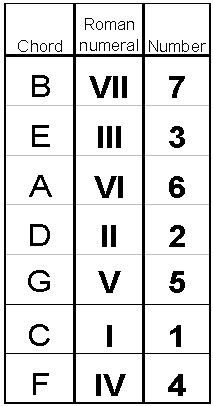Cadences
Cadences consist of two chords that round off a section of music. These are not necessarily found at the end of a musical section, but are often used at the end of a phrase. Within music theory, cadences are often referred to by their roman numerals. The reason for this is so that they do not have to relate to a specific key. in other words, we can talk about a chord relationship V-I (5-1) and how it sounds or how it is used without having to refer to C or G or any other note.
The following is a chart showing how the Roman Numerals fit in with a SeeChord chart.

- Roman Numerals
Given that most progressions involve a downward falling of fifths through a SeeChord chart, it is common to hear phrases such as V-I or ii-V-1 or even vi-ii-V-I. By looking at the above chart, you can see that these simply refer to the patterns you should be getting used to seeing in most SeeChord charts. These progressions are everywhere, but now you can actually see them!
In terms of the types of cadences that are most commonly referred to there are four. These are:
- Perfect
- Plagal
- Imperfect
- Interrupted.
Let us start with the most important.
Perfect Cadence (V-I)
[seeChordViewer src=”/content/Application/Cadences/cadences2-viewer”]
It is quite simply a progression that fally one step on a SeeChord chart. Of course this happens all the time in music so it is important to examint the “Dominant 7th” chord that starts off this beautiful relationship.
So why does the perfect cadence work so well? The secret lies in the use of the dominant 7th chord. The whole reason that this chord is called a dominant 7th is that it is the chord that naturally arises from playing a four note chord starting on the dominant (in this case G). This gives us the chord G-B-D-F. It is the F natural that has particular significance as normally, a G major scale contains an F sharp. By flattening the seventh note of a major 7th chord and thus making a dominant seventh chord we are anticipating the next chord, as F natural is in the C scale, not the G scale. This means that whenever we hear a dominant seventh chord, we are already in the key of the tonic chord, and when we hear a perfect cadence, the dominant seventh is followed by the tonic, thus cementing the relationship.
Regardless of the theory behind a perfect cadence, it is hard to deny that it sounds like an ending. Apocryphally, Mozart’s father would get him out of bed by playing a dominant seventh chord on the piano. Mozart’s delicate ear would be so incensed by the lack of resolution to the tonic that he would be forced to leap out of bed and play the tonic chord!
Here is the start of Eine Kleine Nachtmusik by Mozart:
Classical chord progressions
[seeChordViewer src=”/content/Application/Cadences/cadences3-viewer”]
It is, to say the least unsubtle! This technique is know as key establishment. It basically involves loads of perfect cadences in the same key so that we feel like it is home. When we have been on our journey through the rest of the piece, maybe it makes us feel like we really have returned when the same technique is used at the end. Beethoven was not averse to using countless perfect cadences at the end of his large orchestral works to hammer the key home.
It is tribute to the robustness of the perfect cadence that these pieces do not sound boring. It would seem that the perfect cadence can survive any amount of repetition without losing its original appeal. However, there are alternatives that really come into their own in church music and rock music. There is more on how perfect cadences are used in progressions and modulations in “modulations”
Plagal Cadence (IV-I)
In the world of sacred music, the plagal cadence is King. Many musicians remember the sound of the plagal cadence by mentally singing “Amen”. Of course if this is meaningless to you, it might be more helpful to look for the plagal cadence in rock music! With it’s harder, edgier feel, it often drives the power progressions of rock. Let us have a look at one on a SeeChord chart:
[seeChordViewer src=”/content/Application/Cadences/cadences4-viewer”]
As you can see, the plagal cadence rises from the fourth to the key note or tonic.
Here is the chorus of “Helter Skelter” by Paul McCartney.
[seeChordViewer src=”/content/Application/Cadences/cadences5-viewer”]
[seeChordViewer src=”/content/Application/Cadences/cadences8-viewer”]
[seeChordViewer src=”/content/Application/Cadences/cadences9-viewer”]
[seeChordViewer src=”/content/Application/Cadences/cadences10-viewer”]